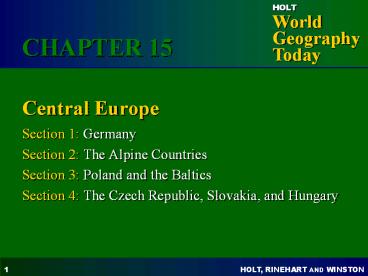Central%20Europe - PowerPoint PPT Presentation
Title:
Central%20Europe
Description:
Section 2: The Alpine Countries. Section 3: Poland and the Baltics ... Krak w beautiful medieval city. Gdansk main seaport and shipbuilding city ... – PowerPoint PPT presentation
Number of Views:24
Avg rating:3.0/5.0
Title: Central%20Europe
1
Central Europe
CHAPTER 15
- Section 1 Germany
- Section 2 The Alpine Countries
- Section 3 Poland and the Baltics
- Section 4 The Czech Republic, Slovakia, and
Hungary
2
Objectives
Section 1 Germany
- What are some key events in the history of
Germany? - What are some features of German culture?
- What is Germanys economy like?
- What issues and challenges does Germany face
today?
3
Key events in German history
Section 1 Germany
- Charlemagne united German kingdoms in the 700s.
- Kingdoms became part of Holy Roman Empire.
- Hanseatic League united northern German towns in
1300s. - Prussia and Hapsburg Empire influenced German
states by 1700s. - Germany lost two world wars.
- Germany divided into Communist East, democratic
West. - West Germany became an economic power.
- Germany united in 1990, after fall of communism.
4
Cultural features
Section 1 Germany
- noted literature and music
- Protestant majority, large Catholic minority
- foodspork, sausage, veal, cheese, pastries
5
Economic features
Section 1 Germany
- powerful economyfourth-largest in the world
- major investors in Central Europe
- manufacturingmachinery, automobiles,
electronics, medical equipment - miningcoal, iron ore Ruhr Valley a key
industrial center - agricultureefficient grains, potatoes, sugar
beets
6
Issues and challenges
Section 1 Germany
- populationaging and immigration are changing
society, causing tension - former East Germanyeconomy and pollution are
problems easterners resentful
7
Objectives
Section 2 The Alpine Countries
- What are some important features of Austrias
history, culture, and economy? - What are the political, cultural, and economic
features of Switzerland?
8
Austria
Section 2 The Alpine Countries
- History
- part of Holy Roman Empire, then Austrian Empire,
then Austro-Hungarian Empire - united with Germany in World War II
- independent since 1955
- Culture
- German language, Catholic religion
- Viennakey city in Central Europe famous for
architecture and music
9
Austria (continued)
Section 2 The Alpine Countries
- Economy
- various industriesmachinery, chemicals
- forestry, hydropower, tourism, foreign trade
10
Switzerland
Section 2 The Alpine Countries
- confederation of 26 cantons
- neutralnot part of UN or EU, but site of various
international organizations - four major languagesGerman, French, Italian,
Romansch - Roman Catholic and Protestant
- high standard of living
- international banking and insurance
- chemicals, pharmaceuticals, watches, farm goods,
tourism
11
Objectives
Section 3 Poland and the Baltics
- What is the history of Poland and the Baltic
countries? - What are the urban environments and economy of
Poland like today? - What influences have shaped culture in the Baltic
countries?
12
History of Poland
Section 3 Poland and the Baltics
- under Russian, Austrian, and German control in
1700s and 1800s - gained independence after World War I
- Communist control after World War II, for more
than 40 years
13
History of the Baltics
Section 3 Poland and the Baltics
- independence from Russia after World War I
- occupied by Soviet Union during World War II
- regained independence in 1991
14
Polish cities and economy
Section 3 Poland and the Baltics
- Warsawcapital and transport hub
- Krakówbeautiful medieval city
- Gdanskmain seaport and shipbuilding city
- economic progress since end of communism
- auto and glass factories weak coal and steel
industries - farming in loess soilscereals, potatoes, sugar
beets - unemployment a problem
15
Baltic influences
Section 3 Poland and the Baltics
- Middle AgesBalts in Latvia and Lithuania Finns
in Estonia - Viking and German invaders influenced Baltic
culture. - Trade brought other foreign influences.
- EstoniaFinnish impact on language, Lutheran
religion - Latviaties to Sweden
- Lithuaniaclose to Polish culture and Catholic
religion - Russian minorities maintain customs.
16
Objectives
Section 4The Czech Republic, Slovakia, and
Hungary
- What are some similarities and differences in the
histories of the Czech Republic, Slovakia, and
Hungary? - What are the Czech Republic and Slovakia like
today? - How has the fall of communism affected Hungary?
17
Comparing histories
Section 4The Czech Republic, Slovakia, and
Hungary
- Slavic peoples inhabited Czech Republic and
Slovakia non-Slavic Magyars occupied Hungary. - All three were part of Austro-Hungarian Empire.
- After World War I, Czech Republic and Slovakia
combined as Czechoslovakia. - Czech lands had minerals and industry Slovakia
was agricultural. - Soviets set up Communist control over both
Czechoslovakia and Hungary.
18
Czech Republic
Section 4The Czech Republic, Slovakia, and
Hungary
- 40 percent Roman Catholic similar percentage
non-religious - Praguelargest city rich heritage modern
American influence - minerals and industrycoal, iron ore, uranium
steel and glass products - farming of cereals and sugar beets
- economic progress slowed in late 1990s
19
Slovakia
Section 4The Czech Republic, Slovakia, and
Hungary
- poorer country
- difficult shift to capitalism high unemployment
- Bratislavacapital and largest city, on Danube
River
20
Hungary and the end of communism
Section 4The Czech Republic, Slovakia, and
Hungary
- difficult change to market economy
- most business privately owned
- growing economy todaynew industry, foreign
investment, tourism - NATO member seeking EU membership































